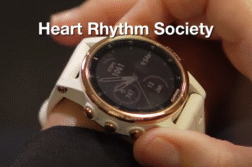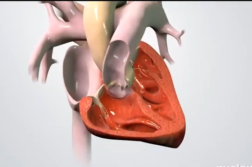Amit Patel, M.D., Director of Clinical Regenerative Medicine and Professor of Surgery, University of Utah School of Medicine, talks about new stem cell research for treating heart failure.
Interview conducted by Ivanhoe Broadcast News in June 2016.
Tell me about the study you just did with the stem cells and the heart.
Dr. Patel: People believe stem cells will cure all disease; the reality is that the potential is great but the reality unfortunately is we’re still learning a lot about them. Cell therapy for the heart has been around for a long time and this is the first study after twenty years that has shown a meaningful clinical benefit to patients. It demonstrated that patients who received their own stem cells that were super charged had fewer deaths and fewer admissions to the hospital for heart failure at one year after therapy. These were extremely sick patients, these weren’t patients who just had small heart attacks: these are patients where your normal left heart function should be about sixty percent, their function was decreased to less than thirty percent, meaning that less than fifty percent of their heart was working. These are patients who have been in the hospital, they have all had prior heart attacks, many of them had pacemakers, defibrillators, so these are very sick people and the likeliness that they’re going to die is greater than fifty percent in the next five years. In this sick population of patients; we harvested three tablespoons of bone marrow, put it in a bioreactor for twelve days and super charged their own cells. All of the young stem cells were expanded and all the old weaker cells that had the effects of aging, diabetes, etc. died off. They ended up somewhere between a hundred and two hundred million cells that we directly injected into their heart while they were still awake with a little catheter and just mapped the inside of the heart to find what part was working and what wasn’t. We found at one year that there was a forty percent reduction in death or hospitalization from heart failure. The question is how does this all work, did we re-grow new muscle, did we make super charged new young cells out of old ones. The reality is these types of cells had more of what we call an immune function: they help the heart start healing itself. Because there’s so much inflammation in heart failure patients and as you get older your immune system is weaker so the cells are weaker because a lot of them have died. We took the unique cells that were still alive and put them in a healthier environment and had their own body start healing the heart. Are these patients going to be able to run marathons? No. But are they going to be able to have a significant impact on their daily life: they’re going to be less short of breath, they’re going to end up in the hospital less, and they’re going to have more stable medication. That’s what we saw at one year is the immune system was triggered in their own heart to actually start help healing from the inside out. This was not a project where we said, we’re going to re-grow new muscle; we do that in the lab all the time that’s just not reality yet for patients.
So is the senator as well as he’s going to get or is he going to continue to get better?
Dr. Patel: He’s probably at a level where he’s at a steady state, meaning that he’s significantly better than when he was hospitalized before, he’s less short of breath and even when you see him compared to if you see your footage from before his color is better, he has more energy, he’s actually lost some healthy weight instead of heart failure weight, he doesn’t retain as much fluid. He’s able to function in his daily life much more efficiently. His quality of life has significantly improved and he has not been hospitalized since the cell injections.
Is the study over?
Dr. Patel: There is still follow up. The patients who did not receive cells who received the salt water are going to be eligible in the next month to cross-over because the study was positive they will all receive cells for free and we will still follow those patients.
What’s next, how long until anybody can get this?
Dr. Patel: Many years. This was what we call a medium size study so we would still need to do another study that’s probably somewhere between four and six hundred patients. If we could show the same effect again then you’d have a reproducible product. The key is not only does it work but more importantly is it safe for these patients who are very sick.
Have you done that with you smaller study, fifty people right?
Dr. Patel: It’s one hundred and fourteen.
And fifty got the—
Dr. Patel: Half received the cells, half received salt water.
The results of this must have been overwhelming.
Dr. Patel: Showing a forty percent reduction has never been shown in any type of therapy. Are we enthusiastic? Yes. The reality is we have to be able to show this in a bigger population to see if this wasn’t just by chance, it is unlikely, but we have to be able to see does this really work in more patients with the same type of disease. These are patients with heart failure caused by having prior heart attacks as opposed to heart failure where you could get it from after having a baby or a virus or valves. There are so many different types; this is a very specific type for people who have heart attacks. That’s still over a couple of million patients in the US.
It seems like stem cells are becoming the answer to a lot of things, is it the wave of the future?
Dr. Patel: It’s always the wave of the future. That’s what they said twenty years ago. Cell therapy, whether it’s the cells themselves, sometimes it’s the factors that the cells release are more important than the cells. A lot of times they discover new drugs from studying stem cells. Are stem cells the future? Yes. We don’t know whether it’s the cells themselves or all the other technologies that are developed related to that but that’s the step by step way of figuring this out. The uniqueness of this is as opposed to a drug; drugs no matter how complex and expensive they are to develop they usually focus on one specific target. That’s why everyone in the industry understands this is the problem and how we’re going to treat it. The problem is stem cells are a completely new way of treating patients because that one cell has so many different effects so it’s hard to come up with a basic science answer of it did exactly this thing and that is why the patient got better. Cells react to the environment they’re put in to. Stem cells are super smart but they don’t know what to do until you put them in the right environment. Whether you put them in to the heart or other parts of the body they sense of what’s going on. If they see there’s a fire they help put it out. They call their friends to help fix it. That’s what happens in heart failure. They themselves may not do a lot but they send out all the right signals, they call all their friends; they call all the people that need to help rebuild and stabilize the problem. In lab dishes we can take the cells and turn them in to new muscle and they contract. That’s very early therapy in terms of putting that in to patients. It is possible, but not somewhere in the near future.
What are the potential side effects in the study, what are some of the things that could go wrong or did go wrong?
Dr. Patel: People who receive any type of therapy could die and these are very sick patients and they’re likely to die anyway independent of the therapy. That was one of the unique findings that the patients who received just the salt water injection had significant increase in bad things happening to them or what we call adverse events. They had more hospitalizations, more of them died and this is not just related to the procedure, this is going all the way one year out. Just being in the study they had what would be normally expected of that patient population. It wasn’t worse for being a part of the trial, if anything usually when patients are in clinical trials they’re overall standard of care is better because they’re seen more often than they normally would. The downside is that’s why you also see what they call a placebo effect. Just being in a trial thinking you received something, you may feel better, and you may walk further. Despite that, this was a randomized totally blinded study so the patients had no idea who received the cells, who didn’t and also the people who are doing the follow up. That’s why this made this very objective that the results that we saw were independent of the usual issues that you may see in smaller studies.
Anything else about the study that I haven’t asked you that you think is important?
Dr. Patel: The key finding of this study was that using the patient’s own cells and super charging them you can start healing the heart. As you get older your stem cells are going to be weaker, they don’t work as well, and putting them in a bioreactor for two weeks was still able to make them young and functional again. This shows that even as you age, and we had patients up to eighty years old; they still had great stem cells. Just because you’re getting older doesn’t mean it’s weaker. The stem cell potential is still there. We just have to understand the biology better to help all of these patients.
END OF INTERVIEW
This information is intended for additional research purposes only. It is not to be used as a prescription or advice from Ivanhoe Broadcast News, Inc. or any medical professional interviewed. Ivanhoe Broadcast News, Inc. assumes no responsibility for the depth or accuracy of physician statements. Procedures or medicines apply to different people and medical factors; always consult your physician on medical matters.
If you would like more information, please contact:
Suzanne Winchester
801-581-3102
Suzanne.winchester@hsc.utah.edu
Sign up for a free weekly e-mail on Medical Breakthroughs called
First to Know by clicking here.




